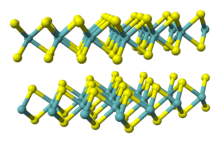Molybdenum diselenide
 | |
| Names | |
|---|---|
| IUPAC name
bis(selanylidene)molybdenum | |
| Other names
molybdenum diselenide, molybdenumdiselenide, molybdenum selenide, diselanylidenemolybdenum | |
| Identifiers | |
| 12058-18-3 | |
| 3D model (Jmol) | Interactive image |
| ECHA InfoCard | 100.031.831 |
| PubChem | 82894 |
| |
| Properties | |
| MoSe 2 | |
| Molar mass | 253.86 g/mol |
| Appearance | crystalline solid |
| Density | 6.980 g/cm3 |
| Related compounds | |
| Other anions |
Molybdenum(IV) oxide Molybdenum disulfide Molybdenum ditelluride |
| Other cations |
Tungsten diselenide |
| Except where otherwise noted, data are given for materials in their standard state (at 25 °C [77 °F], 100 kPa). | |
| Infobox references | |
Molybdenum diselenide (MoSe
2) is an inorganic compound. Its structure is similar to that of MoS
2.[1] Compounds of this category are known as transition metal dichalcogenides, abbreviated TMDCs. These compounds, as the name suggests, are made up of a transition metals and elements of group 16 on the periodic table of the elements.
Structure
Like many TMDCs, MoSe
2 is a layered material with strong in-plane bonding and weak out-of-plane interactions. These interactions lead to exfoliation into two-dimensional layers of single unit cell thickness.[2]
The most common form of these TMDCs have trilayers of molybdenum sandwiched between selenium ions causing a trigonal prismatic metal bonding coordination, but it is octahedral when the compound is exfoliated. The metal ion in these compounds is surrounded by six Se2−
ions. The coordination geometry of the Mo is sometimes found as octahedral and trigonal prismatic.[3]
Synthesis
Synthesis of MoSe
2 involves direct reaction of molybdenum and selenium in a sealed tube at high temperature. Chemical vapor transport with a halogen (usually bromine or iodine) is used to purify the compound at very low pressure (less than 10-6 torr) and very high temperature (600-700 °C). It has to be heated very gradually to prevent explosion due to its strong exothermic reaction. Stoichiometric layers crystallize in a hexagonal structure as the sample cools.[3] Excess selenium can be removed by sublimation under vacuum.[4] The synthesis reaction of MoSe
2 is:
- Mo + 2 Se → MoSe
2
2D-MoSe
2
Single-crystal-thick layers of MoSe
2 are produced by scotch tape exfoliation from bulk crystals or by chemical vapor deposition (CVD).[5][6]
The electron mobility of 2D-MoSe
2 is significantly higher than that of 2D-MoS
2. 2D MoSe
2 adopts structures reminiscent of graphene, although the latter's electron mobility is thousands of times greater still. In contrast to graphene, 2D-MoSe
2 has a direct band gap, suggesting applications in transistors and photodetectors.[5]
References
- ↑ N. N. Greenwood; A. Earnshaw (11 November 1997). Chemistry of the Elements. Elsevier. ISBN 978-0-08-050109-3.
- ↑ Wang, Q. H; Kalantar-Zadeh; Kis, A; Coleman, J.N.; Strano, M.S. Electronics and Optoelectronics of Two-dimensional Transition Metal Dichalcogenides. Nature Nanotechnology [online] 2007, 7, 699-712 doi:10.1038/nnano.2012.193
- 1 2 Parilla, P.; Dillon, A.; Parkinson, B.; Jones, K.; Alleman, J.; Riker, G.; Ginley, D.; Heben, M; Formation of Nanooctahedra in Molybdenum Disulfide and Molybdenum Diselenide Using Pulsed Vapor Transport doi:10.1021/jp036202
- ↑ Al-hilli, A.; Evans, L. The Preparation and Properties of Transition Metal Dichalcogenide Single Crystals. Journal of Crystal Growth. 1972. 15, 93-101. doi:10.1016/0022-0248(72)90129-7
- 1 2 Tue, 04/08/2014 - 11:04am (2014-04-04). "Scalable CVD process for making 2-D molybdenum diselenide". Rdmag.com. Retrieved 2014-04-09.
- ↑ Choi, H. M. T.; Beck, V. A.; Pierce, N. A. (2014). "Next-Generation in Situ Hybridization Chain Reaction: Higher Gain, Lower Cost, Greater Durability". ACS Nano: 140408151851004. doi:10.1021/nn405717p.